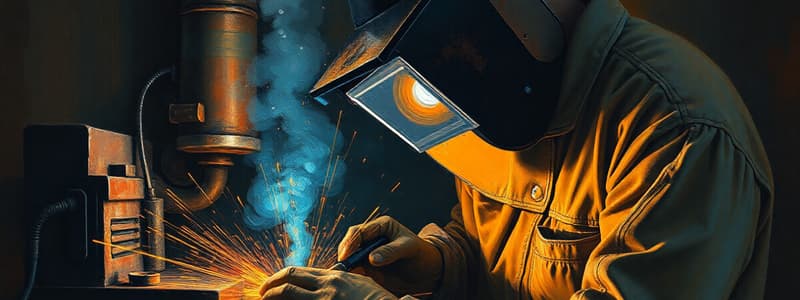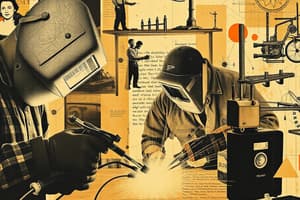Podcast
Questions and Answers
What is the primary influence of heat input in welding?
What is the primary influence of heat input in welding?
- It affects only the cooling rate of the weld.
- It impacts the shape of the heat-affected zone and the microstructure. (correct)
- It has no effect on the mechanical properties of the weld.
- It determines the final color of the weld.
Why is understanding the interaction between base material and filler metal essential?
Why is understanding the interaction between base material and filler metal essential?
- It is crucial for achieving optimal weld performance. (correct)
- It only affects the appearance of the weld.
- It helps in determining the welding speed.
- It is not important as fillers are rarely used.
Which mechanical property is NOT typically evaluated in welded structures?
Which mechanical property is NOT typically evaluated in welded structures?
- Surface finish quality (correct)
- Ductility
- Yield strength
- Tensile strength
What factor is NOT considered in proper weld joint design?
What factor is NOT considered in proper weld joint design?
What do welding procedures primarily specify?
What do welding procedures primarily specify?
What is the primary role of the heat affected zone (HAZ) in welding?
What is the primary role of the heat affected zone (HAZ) in welding?
Which of the following best describes fusion welding?
Which of the following best describes fusion welding?
What impact do defects like porosity and slag inclusions have on welding?
What impact do defects like porosity and slag inclusions have on welding?
Which factor does NOT influence the welding process?
Which factor does NOT influence the welding process?
What happens to the mechanical properties of the heat affected zone (HAZ) compared to the base metal?
What happens to the mechanical properties of the heat affected zone (HAZ) compared to the base metal?
Which of the following welding processes is NOT commonly mentioned?
Which of the following welding processes is NOT commonly mentioned?
What defines the quality of a weld during the welding process?
What defines the quality of a weld during the welding process?
Which material property would NOT affect the choice of welding process?
Which material property would NOT affect the choice of welding process?
Flashcards
Heat Input
Heat Input
The amount of heat applied during welding, measured in joules per unit length (J/mm). It influences weld pool size, HAZ size, and ultimately, the mechanical properties of the weld.
Heat Affected Zone (HAZ)
Heat Affected Zone (HAZ)
The region of the base material directly adjacent to the weld that has been affected by the welding heat, but not melted. It exhibits altered microstructures and properties compared to the base material.
Tensile Strength
Tensile Strength
The ability of a material to resist deformation under applied stress.
Welding Procedure Specification (WPS)
Welding Procedure Specification (WPS)
Signup and view all the flashcards
Welding Standards & Specifications
Welding Standards & Specifications
Signup and view all the flashcards
What is the Heat Affected Zone (HAZ)?
What is the Heat Affected Zone (HAZ)?
Signup and view all the flashcards
What is Fusion Welding?
What is Fusion Welding?
Signup and view all the flashcards
What are Welding Defects?
What are Welding Defects?
Signup and view all the flashcards
What is Welder Theory?
What is Welder Theory?
Signup and view all the flashcards
What is the role of Filler Material in Fusion Welding?
What is the role of Filler Material in Fusion Welding?
Signup and view all the flashcards
What is Welding Metallurgy?
What is Welding Metallurgy?
Signup and view all the flashcards
How do Material Properties affect Welding?
How do Material Properties affect Welding?
Signup and view all the flashcards
How do Welding Processes differ?
How do Welding Processes differ?
Signup and view all the flashcards
Study Notes
Introduction to Welder Theory
- Welder theory encompasses the scientific principles and practices behind joining metals through fusion.
- It considers physical and chemical transformations during welding, impacting weld quality and properties.
- The theory provides a framework for optimizing welding procedures to achieve desired outcomes.
Heat Affected Zone (HAZ)
- The HAZ is the area surrounding the weld in the base metal, affected by welding heat.
- It differs from the fusion zone due to distinct microstructural changes.
- The HAZ exhibits varying metallurgical changes compared to unaffected base metal, impacting mechanical properties.
- These changes can reduce strength, hardness, and ductility in the HAZ compared to the base metal, depending on heat input and material properties.
Principle of Fusion Welding
- Fusion welding joins metals by melting and fusing them together.
- This process uses energy to fuse metals.
- Molten filler metal (if used) fills the joint, solidifying to create a strong bond.
- Fusion welding is widely used for various metals.
Welding Defects
- Welding defects compromise weld integrity and strength.
- Common defects include porosity (trapped gases), slag inclusions (embedded non-metals), cracks (from thermal stress/cooling), incomplete penetration, and undercuts.
- Understanding defect formation is crucial for quality control and prevention.
Influence of Materials and Processes
- Material properties (melting point, thermal conductivity, composition) impact the welding process.
- Different processes (GMAW, SMAW, TIG) have varying characteristics and capabilities.
- Process choice depends on metal type, joint design, and desired weld quality.
Welding Metallurgy
- Welding metallurgy studies microstructural changes during welding.
- Heat input and cooling rates influence crystal structure and grain size in the weld and HAZ, affecting final properties.
- Understanding base material, filler material (if used), and heat input interactions is essential for optimization.
Relevant Parameters
- Heat input critically affects HAZ shape and weld microstructure, impacting weld properties.
- Welding current and voltage affect base material melting rate, needing careful control for quality.
- Welding speed/travel speed relates to heat input, impacting HAZ size and shape.
Mechanical Properties of Welds
- Mechanical properties (tensile strength, yield strength, ductility) evaluate weld quality, especially in structural applications.
- Weld strength is often a significant percentage (or less) of the base material's strength.
- Testing methods include tensile tests, hardness tests, and fatigue tests.
Weld Joint Design and Preparation
- Proper weld joint design maximizes strength and prevents defects.
- Joint surface preparation (cleaning, edge preparation) impacts welding process and quality.
- Design considerations include bevel angle, joint geometry, and fit-up tolerances.
Welding Procedures and Standards
- Welding procedures define steps, parameters, and conditions for specific materials and joints.
- Standards and specifications, best practices, and regulations set weld quality benchmarks.
- Adhering to established procedures and standards ensures weld integrity and safety.
Studying That Suits You
Use AI to generate personalized quizzes and flashcards to suit your learning preferences.




